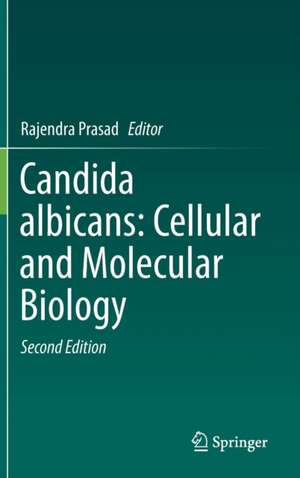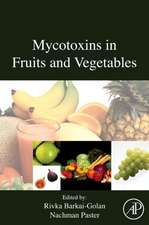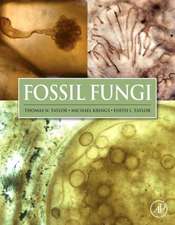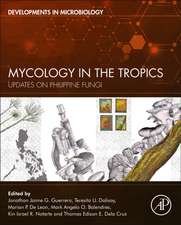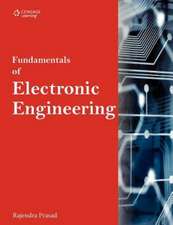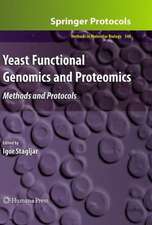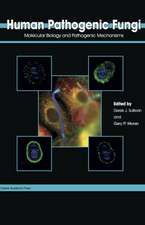Candida albicans: Cellular and Molecular Biology
Editat de Rajendra Prasaden Limba Engleză Hardback – 10 feb 2017
This comprehensive 2nd Edition includes chapters on fungal infections, hyphal morphogenesis, molecular mechanisms of antifungal resistance, antifungal agents, multidrug transporters, virulence mechanisms in Candida albicans, host–pathogen interactions, the cell wall, fungal biofilms, lipids and antifungal resistance, signaling mechanisms and last but not the least host-immune responses. As such, it offers an ideal reference guide for mycologists, researchers, pharmacists, clinicians, and undergraduate students engaged or interested in fungal research. It will also benefit clinicians, who are required to keep abreast of the current state of research on antifungal drug resistance and antifungal development.
| Toate formatele și edițiile | Preț | Express |
|---|---|---|
| Paperback (2) | 581.64 lei 38-44 zile | |
| Springer – 7 dec 2011 | 581.64 lei 38-44 zile | |
| Springer International Publishing – 4 mai 2018 | 1229.58 lei 43-57 zile | |
| Hardback (1) | 1235.88 lei 43-57 zile | |
| Springer International Publishing – 10 feb 2017 | 1235.88 lei 43-57 zile |
Preț: 1235.88 lei
Preț vechi: 1507.17 lei
-18% Nou
Puncte Express: 1854
Preț estimativ în valută:
236.48€ • 247.57$ • 195.68£
236.48€ • 247.57$ • 195.68£
Carte tipărită la comandă
Livrare economică 07-21 aprilie
Preluare comenzi: 021 569.72.76
Specificații
ISBN-13: 9783319504087
ISBN-10: 3319504088
Pagini: 554
Ilustrații: XII, 554 p. 60 illus., 30 illus. in color.
Dimensiuni: 155 x 235 x 32 mm
Greutate: 0.97 kg
Ediția:2nd ed. 2017
Editura: Springer International Publishing
Colecția Springer
Locul publicării:Cham, Switzerland
ISBN-10: 3319504088
Pagini: 554
Ilustrații: XII, 554 p. 60 illus., 30 illus. in color.
Dimensiuni: 155 x 235 x 32 mm
Greutate: 0.97 kg
Ediția:2nd ed. 2017
Editura: Springer International Publishing
Colecția Springer
Locul publicării:Cham, Switzerland
Cuprins
Fungal infections.- Fungal infections- The South-Asian perspective.- Regulatory pathways during C. albicans infections.- Virulence mechanisms and regulation.- Signalling mechanisms in pathogenesis and virulence of C. albicans.- Biofilm development.- Biofilm development and resistance mechanisms.- Biofilm of C. albicans: development and regulation.- Host immune responses during infections.- Mechanism of drug resistance.- Structure- function analyses of Multi-drug transporters.- All about MFS multi-drug transporter of Candida albicans.- Inhibitors/Modulators of MDR transporters.- Inhibitors/Modulators of MDR proteins/transporters.- Anti-fungals.- Anti-microbial peptides.- Anti-candidial agents.- MDR1 and its regulation.- Genomics and Anti-fungal resistance.- Genomics and Anti-fungal resistance.- Lipids and Multi-drug resistance in Candida albicans.- Cell wall of Candida albicans and its role in virulence.- Hyphal morphogenesis of C. albicans.- Innate immune defences against fungal infections.
Notă biografică
Prof. Rajendra Prasad has recently joined Amity University, Gurgaon as Director of the Amity Institute of Biotechnology and Amity Integrative Sciences and Health. He is a former Professor & Dean of the School of Life Sciences at Jawaharlal Nehru University (JNU), New Delhi, where he served for 40 years in various capacities which included Chairman of Molecular Medicine and Rector (Pro-Vice-Chancellor). Holding a Ph.D. from the Central Drug Research Institute, Lucknow, Prof. Prasad has also served as a visiting professor at several universities and institutes, including the Ecole Normale Superieure – CNRS Paris, France; Catholic University, Louvain-la – Neuve, Belgium; Technical University, Valencia, Spain; Bristol Mayer Squib, Princeton, USA; University of Darmstadt, Germany; and New York Medical College, USA.
Prof. Prasad is a recipient of the Royal Society Commonwealth Bursary, Alexander von Humboldt-Stiftung Fellowship, Welcome Foundation Grant, and the Mercator Professorship at the University of Bonn. He is an elected fellow of all Indian Science Academies, a European Commission Focal Point Coordinator, and a Research Ambassador, Germany. He is also currently Vice President of the Indian National Science Academy, New Delhi.
Prof. Prasad has published over 225 research papers and has handled 50 national and international grants. He is a leading molecular mycologist and has conducted trendsetting research in the area of antifungal clinical drug resistance.
Prof. Prasad is a recipient of the Royal Society Commonwealth Bursary, Alexander von Humboldt-Stiftung Fellowship, Welcome Foundation Grant, and the Mercator Professorship at the University of Bonn. He is an elected fellow of all Indian Science Academies, a European Commission Focal Point Coordinator, and a Research Ambassador, Germany. He is also currently Vice President of the Indian National Science Academy, New Delhi.
Prof. Prasad has published over 225 research papers and has handled 50 national and international grants. He is a leading molecular mycologist and has conducted trendsetting research in the area of antifungal clinical drug resistance.
Textul de pe ultima copertă
This book on Candida albicans and similar pathogens provides a timely overview of the groundbreaking discoveries made in the areas of drug resistance, host–pathogen interactions, virulence, host immune system modulation, etc., in the last two decades.
This comprehensive 2nd Edition includes chapters on fungal infections, hyphal morphogenesis, molecular mechanisms of antifungal resistance, antifungal agents, multidrug transporters, virulence mechanisms in Candida albicans, host–pathogen interactions, the cell wall, fungal biofilms, lipids and antifungal resistance, signaling mechanisms and last but not the least host-immune responses. As such, it offers an ideal reference guide for mycologists, researchers, pharmacists, clinicians, and undergraduate students engaged or interested in fungal research. It will also benefit clinicians, who are required to keep abreast of the current state of research on antifungal drug resistance and antifungal development.
This comprehensive 2nd Edition includes chapters on fungal infections, hyphal morphogenesis, molecular mechanisms of antifungal resistance, antifungal agents, multidrug transporters, virulence mechanisms in Candida albicans, host–pathogen interactions, the cell wall, fungal biofilms, lipids and antifungal resistance, signaling mechanisms and last but not the least host-immune responses. As such, it offers an ideal reference guide for mycologists, researchers, pharmacists, clinicians, and undergraduate students engaged or interested in fungal research. It will also benefit clinicians, who are required to keep abreast of the current state of research on antifungal drug resistance and antifungal development.
Caracteristici
Gives an overview of the cellular and molecular biology of Candida albicans and similar pathogens Addresses both basic microbiology research and clinical aspects Offers an updated and comprehensive reference guide Includes supplementary material: sn.pub/extras
Descriere
Descriere de la o altă ediție sau format:
Candida, which was discovered more than a century ago as a causative organism of oral thrush, is now thought to potentially infect almost every tissue of the human body. Although we still do not have a safe anti-candida drug, the growing pace of progess of research on Candida albicans holds promise that a breakthrough is imminent. Though many monographs and articles on candida and candidoses have appeared in recent years, they mostly cover the clinical aspects. This particular text, however, explains the more basic features of candida including the molecular genetics, molecular biology and immunology of the cell wall, the molecular basis of morphogenesis and the structure and function of the plasma membrane. The role of anti-candida drugs and their mechanism of action are also discussed.
Candida, which was discovered more than a century ago as a causative organism of oral thrush, is now thought to potentially infect almost every tissue of the human body. Although we still do not have a safe anti-candida drug, the growing pace of progess of research on Candida albicans holds promise that a breakthrough is imminent. Though many monographs and articles on candida and candidoses have appeared in recent years, they mostly cover the clinical aspects. This particular text, however, explains the more basic features of candida including the molecular genetics, molecular biology and immunology of the cell wall, the molecular basis of morphogenesis and the structure and function of the plasma membrane. The role of anti-candida drugs and their mechanism of action are also discussed.
